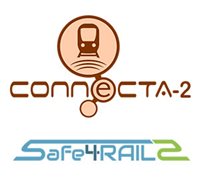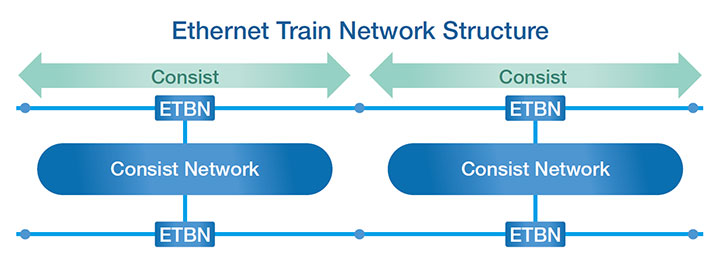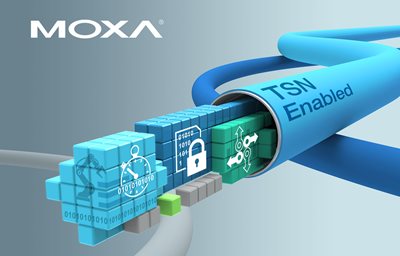Traditionally, it is common in the railway industry to deploy trains with multiple communication networks; one dedicated to the train controls, one for railway signaling, another for video security and passenger information systems, and quite often an additional network for passenger Wi-Fi access. Those communication networks mostly use legacy interfaces such MVB, CAN, and PROFIBUS, which have bandwidth limitations and require a gateway if combined. On the other hand, these networks are physically segmented and clearly separate safety and non-safety functions. However, these types of solutions increase the complexity and cost of train control and monitoring system architecture and ultimately, the train's life-cycle cost.
With the ambitious goal of converging these multiple train networks and cutting train manufacturing and maintenance costs, the CONNECTA-2 and Safe4RAIL-2 projects introduced the Drive-by-Data concept, an approach to digitally transfer all control parameters of the train control and monitoring system (TCMS) subsystems over an electronic network. For that purpose, both consortiums have been working on defining and developing the Next Generation of Train Communication Networks (NG-TCN) based on IEC 61375 to achieve true interoperability between trains from different manufacturers. This new definition includes a renewed design for the train network topology, implements a new safe network inauguration process, increases the safety communications level up to SIL4, and introduces Time-sensitive Networking (TSN) technology. These improvements have already been integrated in NG-TCN devices, as described in the following sections.

The Next Generation of Train Communication Networks (NG-TCN) Increases Safety
a) New Train Network Topology
The new train network topology comprises two independent Ethernet Train Backbone (ETB) data transmission lines to create redundant communication channels for both critical and non-critical data through dynamic VLAN reconfiguration.

b) Safe Train Inauguration
The safe train inauguration process up to SIL4 allows for a robust train coupling and decoupling procedure. This revised mechanism uses standard Ethernet communication to apply train safety functions that rely on parameters from the train inauguration process such as train, consist, and vehicle orientation.
c) Safe Communication Channel
The safe communication channel leverages the SDTv4 protocol to facilitate safety functions up to SIL4 and ensures a safe environment for exchanging point-to-point information between end devices across consists.
d) Time-sensitive Network
TSN technology defines time slots for the exchange of safety-critical data and prevents non-safety critical data from being transmitted over the network during these times.
Interoperability Between NG-TCN Devices
The development of NG-TCN devices, including TSN technology, constitutes a breakthrough in the industry. Moxa, together with other partners of the Safe4RAIL-2 consortium, have successfully developed the NG-TCN devices as a major milestone of creating safer train networks. In particular, the integration of the TSN technology embedded in Moxa’s devices and its subsequent validation for interoperability significantly contributed to achieving the key objectives of the Safe4RAIL-2 project, to merge train networks and cut overall train costs. The highlights of TSN technology are as follows

a) Redundant Clock Synchronization
Redundant clock synchronization as defined in IEEE 802.1AS-rev allows TSN devices to share a common real-time clock across the network and between multiple domains.
b) Deterministic Data Transmission
Scheduled traffic in accordance to IEEE 802.1Qbv ensures critical traffic is transmitted at fixed, predictable time intervals.
c) Redundant Critical Traffic
Frame replication and elimination allows for the transmission of redundant critical traffic between ECNs on both ETB lines in accordance with the IEEE 802.1CB standard.
Overall, the NG-TCN reduces the number of devices and cabling while increasing the overall safety and reliability of train networks. In addition, it enables the reliable transmission of safety-critical data through TSN technology and non-critical data through conventional Ethernet protocols. Moxa, together with the consortium partners, have performed rigorous interoperability testing to verify that the new requirements are properly defined for a future extension of the IEC 61375 standard. The development and integration of these technologies are a big step forward towards realizing the next generation of train communication networks and achieving full interoperability between train manufacturers.
Introducing the Safe4Rail-2 and CONNECTA-2 Project
Appendix A
What Is Time-sensitive Networking (TSN)?
TSN is a collection of standards that enables deterministic messaging over standard Ethernet networks. As defined by the Institute of Electrical and Electronics Engineers (IEEE), TSN involves a form of network traffic management to ensure non-negotiable time frames for end-to-end transmission latencies. All TSN devices synchronize their clocks with each other and use a common time reference to support real-time communication for high-precision industrial control applications.

This project has received funding from the European Union’s Horizon 2020 research and innovation programme under grant agreement No. 826073. The information and views set out in this document are those of the author(s) and do not necessarily reflect the official opinion of Shift2Rail Joint Undertaking. The JU does not guarantee the accuracy of the data included in this article. Neither the JU nor any person acting on the JU’s behalf may be held responsible for the use which may be made of the information contained therein.